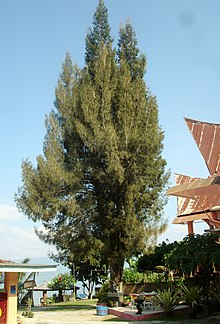Casuarinas
| Casuarinas | ||||||||||||
|---|---|---|---|---|---|---|---|---|---|---|---|---|

Horsetail-leaved casuarines ( Casuarina equisetifolia ), branches with inflorescences |
||||||||||||
| Systematics | ||||||||||||
|
||||||||||||
| Scientific name | ||||||||||||
| Casuarina | ||||||||||||
| L. |
Casuarines ( Casuarina ) are a genus of plants from the order of the beech-like (Fagales). Occasionally, however, the German term Kasuarine is also used for the genera Allocasuarina and Gymnostoma , which also belong to the casuarina family . This is mainly due to the fact that all 70 species of the casuarina family were previously assigned to this genus.
Description and ecology


Vegetative description
The Casuarina species are trees that grow in forests or arid areas, the branches of which are reminiscent of horsetail . The photosynthesis was mainly in the stem axis shifted, the leaves are greatly reduced. The fine leaves are in stem-like whorls of five to 20 leaves, they are simple, fused, sessile and membrane-like. The leaf margins are smooth. Stipules are missing.
Inflorescences and flowers
Both hermaphroditic and unisexual flowers are formed, there are monoecious ( monoecious ) and dioecious ( dioecious ) species. The pollination is carried by the wind. There are spiked or kopfige inflorescences formed. Purely male inflorescences are simple, elongated spikes, female inflorescences are on short side branches, the appearance of which differs from the vegative branches. The fruit stands are conical.
Bracts and bracts sit under the small flowers . A perianth of one or two scales is stunted in the male flowers found in the female flowers she absent. The Andrözeum is unbranched, but tends to divide. It consists exclusively of fertile stamens . The anthers are fixed to the base and open via longitudinal slits. Two fruit leaves are a two-chambered ovary grown, with a pointed stylus and two scars . Each carpel has two ovules lying next to one another , which are not covered by a seed coat and grow upright.
Fruits and seeds
The fruits are dry wing nuts that are winged at the tip. The fruits do not pop open, the fruits of neighboring flowers combine to form a collective fruit. However, the partial fruits of this collective crop are not fused. The seeds do not contain endosperm ; the unbent embryo is fully developed and has two oily cotyledons .


Systematics and distribution
The genus Casuarina was established by Carl von Linné in 1759 . Type species is Casuarina equisetifolia L. The generic name Casuarina is derived from the Malay Kasuari and refers to the similarity of the "leaves" with the feathers of the bird cassowary ( Casuarius ).
The species of the genus Casuarina are native to Australia and the islands to the north of it. Individual species can be found pantropically today.
There are around 14 types of casuarina :
- Casuarina collina Poiss. ex Pancher & Sebert : The home is New Caledonia .
- Casuarina cristata Miq. : The home is eastern Australia .
- Casuarina cunninghamiana Miq. : The two subspecies are common in central and eastern Australia.
- Horsetail-leaved cassuarines ( Casuarina equisetifolia L. ): The two subspecies are distributed from India to the islands in the western Pacific.
- Casuarina glauca Spreng. : The home is eastern Australia.
- Casuarina grandis L.ASJohnson : The home is Papua New Guinea .
- Casuarina young fowl Miq. : The homeland is Java and the Lesser Sunda Islands .
- Casuarina obesa Miq. : It is common in the Australian states of southwestern Western Australia , Victoria and southwestern New South Wales .
- Casuarina oligodon L.ASJohnson : The two subspecies occur in New Guinea .
- Casuarina orophila L.ASJohnson : The home is New Guinea.
- Casuarina pauper F. Muell. ex LASJohnson : The homeland is eastern and southern Australia.
- Casuarina potamophila Schltr. : The home is New Caledonia.
- Casuarina tenella Schltr. : The home is New Caledonia.
- Casuarina teres Schltr. : The home is New Caledonia.
swell
Individual evidence
- ↑ a b c d Casuarina in FloraBase: in FloraBase - Western Australia Flora .
- ↑ Umberto Quattrocchi: CRC World Dictionary of Plant Names . I AC. CRC Press, 2000, ISBN 978-0-8493-2675-2 , pp. 456 ( Casuarina on p. 456 in the Google book search).
- ↑ a b c d e f g h i j k l m n o Rafaël Govaerts (Ed.): Casuarina. In: World Checklist of Selected Plant Families (WCSP) - The Board of Trustees of the Royal Botanic Gardens, Kew . Retrieved January 13, 2015.
Web links
- KL Wilson, LAS Johnson 1990, revised by KL Wilson in February 2014: Casuarina - data sheet at New South Wales Flora online .

